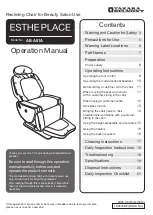
31
E
3
Ti
ps and Gener
al ins
tructions
3. Tips and General Instruction:
Film-Look: Which elements are important?
Framerate:
Film works only with complete pictures, that means progressive with 24 or 25 Hz.
Television systems work currently for the most part with half pictures (interlaced), that
means with 50 or 60 Hz.
The higher the frame rate, the higher is also the motion resolution.
A football game with “only” 24 Hz would not be as informative for the viewer as football
game with 50 Hz.
Exposure time:
The common shutter speed result for fi lm cameras result normally from the frame rate. This
is mostly 1/48 s., 1/50 s. or 1/60 s., some applications request a shorter exposure time.
Electronic cameras work generally in the same manner, but the consolidation between
frame rate and exposure time is not as steep. This means at for example 60 frames per
second there is also a longer exposure time possible (up to 360 degrees Hell sector =
1/60 s.)
Motion blur:
One characteristic of the so called fi lm look is the motion blur.
Low frame rate / long exposure time lead to a higher motion blur compared to television
- benefi t from this creative tool.
Shutter effect / strobing:
Is your pan jerky? Probably your pan velocity is not adjusted to your frame rate (and your
motion blur). Check the pan velocity against the focal distance, e. g. in the manual of the
ASC (American Society of Cinematographers).
Also newer monitors show the pictures often “jerky”. Chose your equipment accordingly to
your reporting (TV/cinema) and your method of recording (interlaced/progressive).
Method of recording:
INTERLACED is still a widespread method for increasing the motion resolution
(50/60 Hz). Use this method creatively, e. g. for a later slow motion (Example: convert
50/60 Hz interlaced to 50/60 Hz progressive, afterwards rendering with 24/25 frames/s.).
De-interlaced is often used for the print out.
PROGRESSIVE is used for printing out the material; this is often more close to the fi lm
look, because of a lower motion resolution (24/25 Hz).
Compression:
Unfortunately the recording quality is highly dependent on the format of recording. A lot
of today’s used data compression programs are for example highly sensitive to noise or
quickly changing picture contents. While recording do not only trust your picture on the
monitor (it shows often the uncompressed signal), but test how the recorded signal is
behaving in different recording situations (see also: TARGET SPEED above).
–
–
–
–
–
–
















































